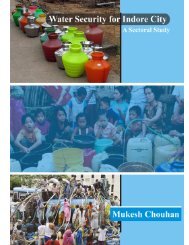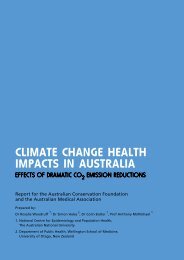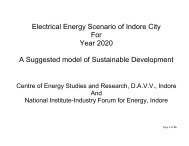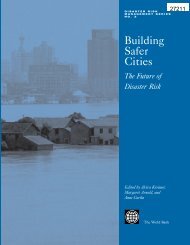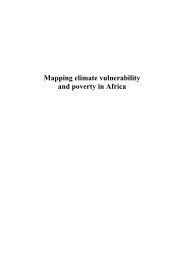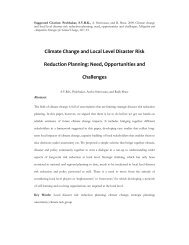Indore City Resilience Strategy - ImagineIndore.org
Indore City Resilience Strategy - ImagineIndore.org
Indore City Resilience Strategy - ImagineIndore.org
You also want an ePaper? Increase the reach of your titles
YUMPU automatically turns print PDFs into web optimized ePapers that Google loves.
A. Variability & Change B. Possible Impacts C. Evaluation & Assessment D. Prioritized Strategies<br />
Vulnerability<br />
Assessment<br />
1. Drainage and Sewerage Vulnerability Index (DSVI)<br />
2. Loan and Insurance Vulnerability Index (LVA)<br />
3. Water Scarcity Index (WSI)<br />
1. Drainage and Sewerage vulnerability index (DSVI)<br />
The condition of sewerage and drainage is poor in most study areas due to limited investments in the past along with poor maintenance. The study also indicated that<br />
significant proportion of middle class and upper SECs also do not have access to sewerage (septic tanks, soak pits etc) and drainage is inadequate. As per NIPFP, 55%<br />
population has access to sewerage network and 80% of sewers are under utilized for want of maintenance and only 20% of roads have storm water drainage (NIPFP,<br />
2006).<br />
More than half the sample households (predominantly poor) reported dumping of solid wastes in open areas or streams, resulting in clogging of the drainage system<br />
which further deteriorates the environment and increase water logging during and after rainy season. Large sections of the new areas included into the municipality<br />
still have septic tank toilets. The low permeability of black cotton soils as well as poor solid waste collection system further aggravates this situation. During and after<br />
rainy seasons, outbreaks of vector borne diseases like malaria and dengue are common. The analysis indicates that there are two types of slums; one having minimal<br />
drainage and sewerage while the other has fairly good facilities. This is due to focused investments under many pro-poor programmes including Madhya Pradesh<br />
Urban Services for Poor (MPUSP).<br />
2. Loan and insurance vulnerability Index (LVA):<br />
Loan is the most common issue as vulnerability for the poor. Mainly it is towards insurance, to protect the households against loss of assets or medical emergencies to<br />
family members. The penetration of insurance is poor (less than 25%) as well as incidence of loans is higher in case of lower and slum SECs. This causes higher<br />
financial vulnerability to these households. These results have to be seen in conjunction with income stability index.<br />
3. Water Scarcity Index (WSI)<br />
Water availability is observed to be 52-67 LPCD and is very low as per CPHEO norms of 135 LPCD (Water Sector Study-Draft, 2009). Only 54% of population is<br />
covered by piped water supply (alternate day for an hour), while the rest utilize the ground water or buy water (water tankers).<br />
The vulnerability analysis indicates that all the SECs suffer from water scarcity with more than 40% of households reporting WSI >4. Slum and lower middle class are<br />
the differentially vulnerable with nearly half the households facing acute water scarcity (>4).<br />
Presently water supply of additional 90 MLD water under phase III has already started. This has partially relived the scarcity of water at the city level.<br />
42<br />
Vulnerability Assessment<br />
DSVI | LVA | WSI<br />
Capacity



